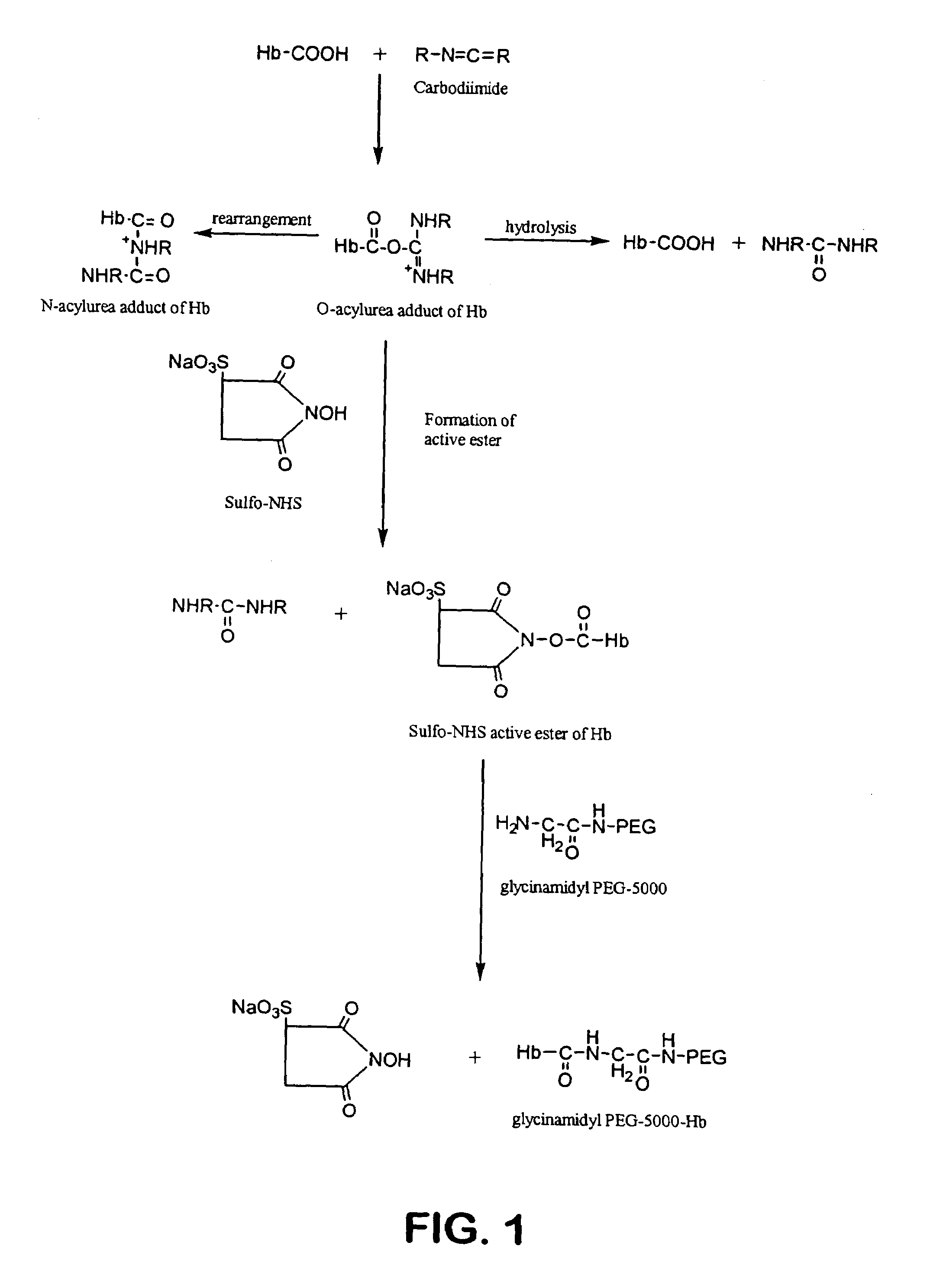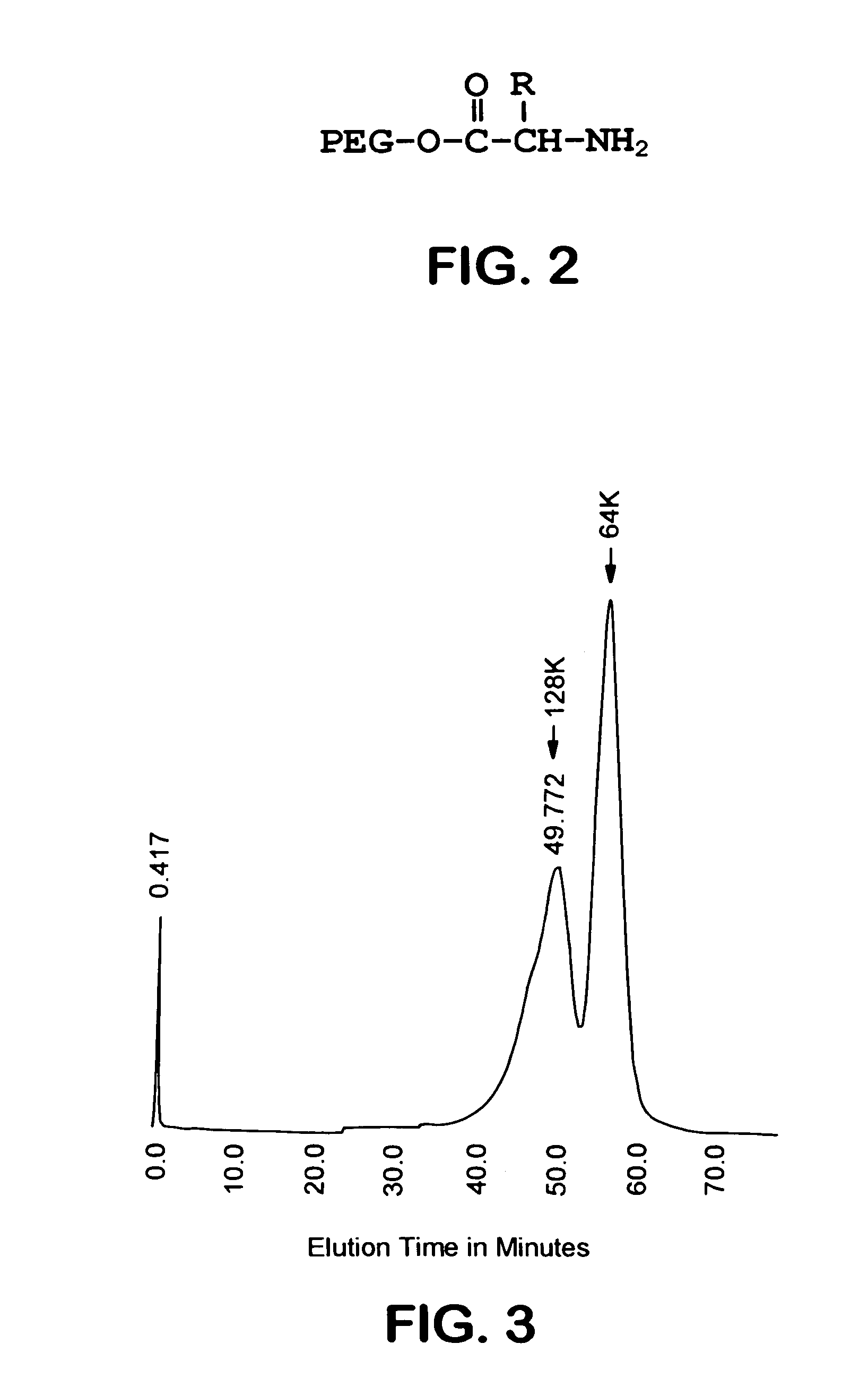Size enhanced hemoglobins: surface decoration and crosslinking of the protein with polyoxy alkylene glycols
a technology of polyoxy alkylene glycol and modified hemoglobin, which is applied in the direction of antinoxious agents, drug compositions, peptide/protein ingredients, etc., can solve the problems of short circulation half-life of hb, hampered by the short oxygen affinity, and the difficulty in synthesizing the modified hb
- Summary
- Abstract
- Description
- Claims
- Application Information
AI Technical Summary
Benefits of technology
Problems solved by technology
Method used
Image
Examples
example 1
Preparation of Bifunctional Glycinamidyl PEG
[0142]5 Grams of O,O′(2-amino propyl) polyethylene glycol 600 (diamino PEG-600) was acylated with about two molar equivalents of BOC (tertiary butyloxy carbonyl)Glycyl-ONSu (N-hydroxy succinmidyl ester of t-butyloxy Glycine) in dry tetrahydrofuran at room temperature. After 16 hours, the analytical TLC showed trace amounts of unreacted amino compound. The solvent was evaporated under reduced pressure, and the residual oil is treated with trifluoroacetic acid:dichloromethane (TFA:DCM) at a 1:1 ratio by volume. The dry product was dried under vacuum over sodium hydroxide pellets and 4.5 grams of bifunctional glycinamidyl PEG was recovered.
example 2
Preparation of Monofunctional Glycinamidyl PEG
[0143]5 Grams of omega methoxy monoamine PEG was acylated with about one molar equivalent of N-hydroxy succinimidyl ester of t-butyloxy glycine in dry tetrahydrofuran at room temperature. After 16 hours, the analytical TLC showed trace amounts of unreacted amino compound. The solvent was evaporated under reduced pressure, and the residual oil is treated with trifluoroacetic acid:dichloromethane (TFA:DCM) at a 1:1 ratio by volume. The dry product was dried under vacuum over sodium hydroxide pellets and 4.8 grams of monofunctional glycinamidyl PEG was recovered.
example 3
Preparation of Hemoglobin A Decorated with Glycinamidyl PEG-5000.
[0144]A 2.0 mM solution of hemoglobin A (HbA) (in the oxy state) is dialyzed overnight at 4° C. against 20 mM MES buffer, pH 6.0. A 50 mM solution of glycinamidyl PEG-5000, and a 20 mM solution of N-hydroxysulfosuccinimide, both in MES buffer at pH 6.0 is also prepared. The HbA, glycinamidyl PEG-5000, and N-hydroxysulfosuccinimide solutions are mixed together to final concentrations of 0.5 mM HbA, 25 mM glycinamidyl PEG-5000, and 5 mM N-hydroxysulfosuccinimide. The reaction is initiated by the addition of 1-ethyl-3(3′-dimethylaminopropyl)carbodiimide (EDC) from a stock solution to a final concentration of 20 mM. The concentration of EDC stock solution is such that the volume of the solution added to initiate the amidation reaction is less than 2% of the total reaction volume. After addition of EDC, the reaction mixture is incubated at room temperature for 1 hr. The PEGalated HbA is separated from any non-PEGalated HbA ...
PUM
| Property | Measurement | Unit |
|---|---|---|
| total mass | aaaaa | aaaaa |
| pKa | aaaaa | aaaaa |
| pH | aaaaa | aaaaa |
Abstract
Description
Claims
Application Information
 Login to View More
Login to View More - R&D
- Intellectual Property
- Life Sciences
- Materials
- Tech Scout
- Unparalleled Data Quality
- Higher Quality Content
- 60% Fewer Hallucinations
Browse by: Latest US Patents, China's latest patents, Technical Efficacy Thesaurus, Application Domain, Technology Topic, Popular Technical Reports.
© 2025 PatSnap. All rights reserved.Legal|Privacy policy|Modern Slavery Act Transparency Statement|Sitemap|About US| Contact US: help@patsnap.com



